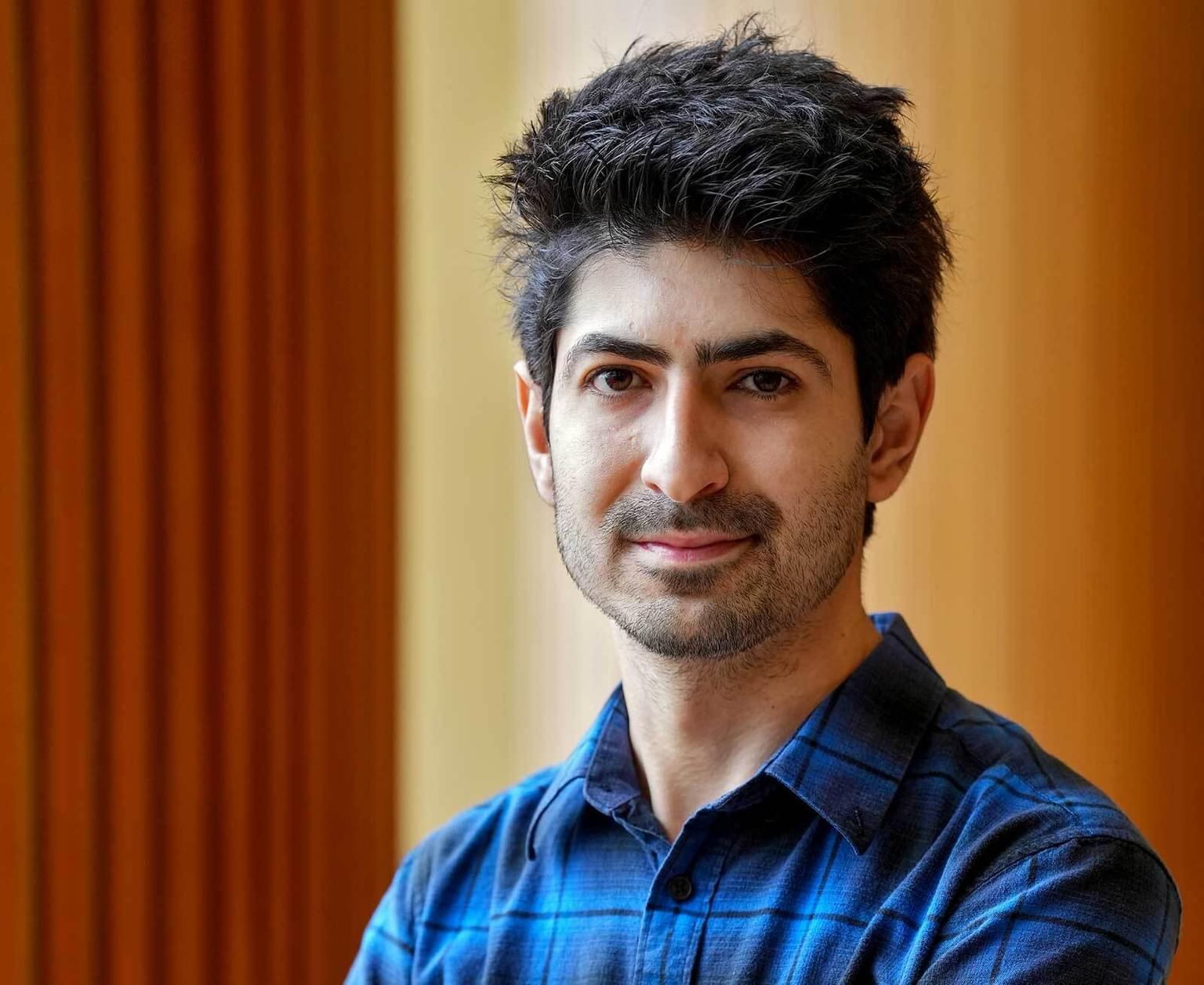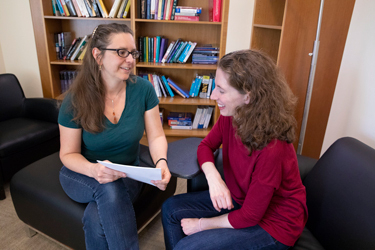News

03 April 2025
Does a cell’s “type” define its function?
A recent article co-authored by Stowers Investigator reviews current neurobiology research to highlight and foster scientific discussion.
Read Article
News
Scientific trio works together to expand the flatworm community toolbox

By Dianna Bautista
When Stephanie Nowotarski, PhD, began her postdoctoral work in the laboratory of Alejandro Sánchez Alvarado, PhD, in 2016, it was her first experience using planaria—a type of flatworm—as a research organism. Nowotarski’s background was in cell and developmental biology and her research project involved using 3D electron microscopes to take images of planaria. In the early days of the project, she spent much of her time studying the organism’s anatomy and structure. There wasn’t a database for planarian research at the time, and Nowotarski found herself reading research papers from the 1960s that were full of low-quality images.
She started thinking, “There has to be an easier way. I don't want to see anyone else take the time that I have—three years—to learn and figure out what I'm even looking at and how to process it.”

A portion of the structure of an ontology. Each dot is an anatomical term and the lines represent relationships that connect them. Clustering the data visually like this allows researchers to see that highly related items.
That same year, Nowotarski met Sofia Robb, PhD, a genomics scientist at the Stowers Institute, who has a passion for sharing data and making it more efficient. Robb had a project that she felt would fit with what Nowotarski wanted to accomplish. The project was to create an ontology for planarian anatomy.
An ontology is a framework for organizing and aggregating data related to a concept. It can be used as a resource to show relationships between different ideas, terms, people, and so on. For example, an ontology about the NFL might include “football player” as a term and “Patrick Mahomes” as a player. The ontology could also connect football and Mahomes to create the sentence “Patrick Mahomes plays football.”
A couple of years later, Robb, Nowotarski, and another Sánchez Alvarado Lab postdoctoral researcher, Erin Davies, PhD, produced PLANA (pronounced PLAN-A), a planarian anatomy ontology which features 850 anatomical terms and shows how terms are related. The living document is still growing, and the team’s work is described in a 2021 publication in the journal Development and a web resource. Davies has since completed her postdoc at Stowers and currently runs her own lab at the National Cancer Institute of the National Institutes of Health where she studies the regeneration potential of planarian embryos.
Joining Forces
Just prior to the current work, Robb and Davies had collaborated on a glossary of planarian anatomical and embryonic terms. “When we started on the glossary, I thought, ‘Oh, this could be so much more!’ ” Robb recalls. The glossary organically led to discussions about an ontology when the pair realized they wanted to categorize and organize the data into a hierarchy.

When Nowotarski’s 3D imaging project surfaced, the team was set. Each person played a crucial role and brought their expertise to the table. Robb was the tech-savvy facilitator who helped develop the back-end code structure and brought people together. Throughout the process, Robb contacted and learned from other ontologists in the scientific community. Davies, who enjoys defining and organizing things, was a domain expert helping to compile, aggregate, and organize all of the developmental anatomy data. Nowotarski, who enjoys the idea of things as concepts and was frustrated by the lack of a planarian database, contributed the electron microscopy imaging data and served as a liaison between the computational and biological aspects of the collaboration.
“We complement each other and worked really well together. I don't think this project could have been done without all three of us,” says Robb.
Outcomes Unimagined
When the team started working on the project, they didn’t expect it to grow to the extent that it did. As Davies explains, “There was this very organic process that came about where we all started working together. I don't think we even set out that this is a standalone project that we're publishing. It was just smaller scale and it really evolved over time.”
One of the first signs of the project’s growth was the changing timetable. Nowotarski jokingly recalls Robb and Davies’ original plan, “At one point Sofia and Erin said ‘It’s only going to take a year.’ Seriously, anytime anybody says that, automatically multiply it by three.”
The initial goal for PLANA, however, remained the same: to help researchers avoid the search dilemma Nowotarski had experienced. In that way, the resource could be used as a tool to help people find information and facilitate research.
Similar to the Mahomes example, the structure of PLANA allows glossary terms and the relationships between them to form sentences. These sentences can be interconnected to form a web network. Within the web, users can search for terms and find related items. For example, if you wanted to find data about the planarian head, you would find associated terms and anatomical features found in the head as well as imagery, associated gene transcripts, and links to papers which provide more information about this structure.
Another goal for PLANA was to make the resource usable by the wider scientific community, including comparative biologists and flatworm enthusiasts. Therefore, the team needed to make the ontology interoperable with other ontologies.
“Sofia paid a lot of attention to building the ontology in a way that it will interface well and talk to other ontologies,” states Davies. “It makes it easier for people to use, so that we're part of the broader biological space that's being investigated.”

A planarian anatomy ontology. The size of the word correlates to how many times it was used in the literature.
Massive Data
While Robb was becoming an authority on how to build ontologies, Nowotarski and Davies had the hefty task of going through the data and cross-checking against each other to determine the best way to organize it. They read countless research papers to compile terms. There were questions about how to define terms and how they were related. In doing this, they realized that researchers have synonyms for the same terms or sometimes lack a term altogether. Yet, the ontology still had to incorporate that human variability.
The duo applied rules to the ontology and retooled when a rule didn’t hold up. They met often to discuss their questions and findings.
“We needed those conversations to arrive at a consensus and ensure that we were doing things in a consistent way and a systematic way. And we enjoyed spending the time together,” Davies notes.
That communication was necessary as it was a lot of data to get through. Especially when the team decided to include gene transcripts associated with the terms, similar to the process of annotating a bibliography.
“It was a big effort. I mean it was a really big, humongous amount of data…It’s just amazing what we did,” says Robb with a smile.
The Space to Explore
“We did not set out to build an ontology,” explains lab leader Sánchez Alvarado, Stowers executive director and chief scientific officer, and Howard Hughes Medical Institute Investigator. “Our research goal was to better understand the anatomy of our research organism. But as we embarked on this project, we realized we were lacking the adequate tools to meet this challenge.”

In a lighter moment of collaboration, the team had photos snapped in a photobooth at an international planarian meeting.
“In any other place, this shortcoming would have likely been a showstopper,” says Sánchez Alvarado. “But we are fortunate to be at the Stowers Institute, where we can take ideas and turn them into reality. The work spearheaded by Steph, Sofia, and Erin is emblematic of what we can accomplish as scientists at our institution.“
Next Up
Throughout the project, the team had fun working together. “We’ve had a heck of a time working with each other. The key is that none of this was super painful at any point,” states Nowotarski, as Davies and Robb nod in agreement.
The team plans to continue working together and growing this living document. They hope to get stakeholders to contribute to PLANA with their own knowledge and expertise. As part of that step, they are planning a Tweetorial (Twitter tutorial) for the flatworm community to show them what PLANA can do, how it can help researchers, and why they should care about it.
“The more people that see the value of continuing to adapt and expand the ontology, the better off and stronger the resource will be,” Davies explains.
Having caught the ontology bug, this isn’t the only one they are planning. Nowotarski and Robb are working with another Stowers laboratory to make a database for sea anemone. In the pipeline are plans for an apple snail anatomy ontology, and, in a very draft form, PLANP, Robb’s project which focuses on planarian phenotype, or visible traits.
“For me, the joy is always knowing that science is never done in a vacuum,” Nowotarski explains. “It's always part of a community. This experience and paper really pulled that together and meant that in a lot of different ways.”
News

03 April 2025
A recent article co-authored by Stowers Investigator reviews current neurobiology research to highlight and foster scientific discussion.
Read Article
News

01 April 2025
Brown, who held key leadership roles for both organizations, passed away March 27, 2025.
Read Article
Press Release

27 March 2025
Alejandro Sánchez Alvarado, Ph.D., receives recognition as a leader and expert in regenerative biology and its potential to transform human health.
Read Article
